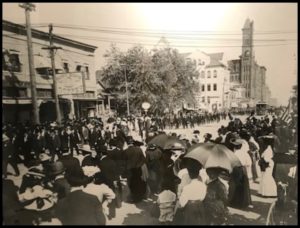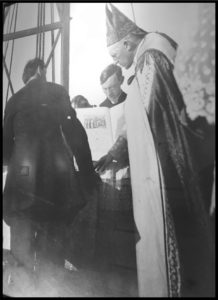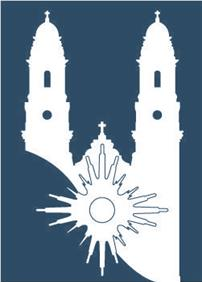The Cornerstone Ceremony

Two years after the ground had been broken, the foundation was completed. The walls were brought up to the level for the main floor and it was time to lay the cornerstone. Sunday, October 6, 1907, was the day set aside for the occasion and no detail was left undone to make the event the most memorable, the most outstanding, and the most unique in the history of the Church in Nebraska.
Newspaper headlines of the day read: "Saint Cecilia's Cathedral reverently consecrated in the presence of 30,000 people" . . . "10,000 people march in the parade."
From the World-Herald, "It was a magnificent and imposing army of men, that which marched over the hot pavements from downtown yesterday to the new Saint Cecilia's Cathedral as a preliminary to the cornerstone laying exercises. It was the greatest religious demonstration of that character which Omaha has ever witnessed or ever may witness. The parade was composed of a body of men two miles long marching six abreast. It was formed on Farnam street between seventeenth and twentieth. As an instance of its length, the head of the procession turned the corner at Thirty-ninth and Davenport streets just as the last body of men which had been standing at rest on twentieth, wheeled into line and took up the sweltering two-mile march.
"One of the most interesting features was the strictly civilian character of the parade. While a few bodies wore the uniform of some society and a few others gave a distinctness to their sections by wearing belts, caps or badges of a uniform in character, the parade as a whole gave the appearance of a great gathering of every-day, middle-class prosperous American citizens. Those who witnessed the parade and made any attempt to estimate its numbers think 10,000 a not too extravagant guess."
The World-Herald article continues . . . "Each parish and church society carried at its head a banner designating it, and each division of the parade was preceded by a band. The line of march was from Twentieth street on Farnam to Thirty-ninth, thence to fortieth and then directly to the Cathedral. People lined the streets all along the route and comments on the splendid showing were not infrequent.
"At the head of the procession rode a platoon of mounted policemen under the charge of Chief Donahue and Sergeant Hayes. Immediately following were the Knights of Columbus, the Omaha and Council Bluffs lodges, making a total of more than four hundred men.
"The management of the parade was so thoroughly systemized that there wasn't a hitch in the plans for the formation of the line to the final dispersion of the great civilian forces. As fast as a body of marchers appeared at the rendezvous, it was assigned a position on one of the side streets near Farnam and held there in march formation until its turn. J.A.C. Kennedy, marshall of the day, had as his aids, W.A. Schall, assistant marshall, T.F. Swift, Arthur Coad, A.E. Melady, Dr. F.J. Langdon, Charles Garvey, William Beahr, William Donahue and Fred Hermank.
"As the van approached the new cathedral, the clergy and choir, which had been stationed at the Saint Cecilia parochial school, marched to the reviewing stand. The choir led the way, followed by the monsignors, local and visiting bishops and archdeacons in the ecclesiastical robes. Each bishop had as excort two priests, while the archbishops were accompanied by the lay chairmen of the committee.
"A small stand had been erected for the bishops and archbishops at the Fortieth and Burt corner of the cathedral (near the spot where the altar of the church would stand), and it was from there they reviewed the procession as it rounded the corner and marched to the east end of the new structure where the exercises were held.
"As the marchers approached the reviewing stand they uncovered and remained so until ten feet beyond as a salute to the church dignitaries. From the reviewing stand the procession proceeded to a great vacant common, which had been reserved for them in front of the speakers' platform where they stood at rest during the ceremonies. The aides and banner carriers were grouped to one side on the platform in a space reserved for them and made a billiant bank of color with all the miltitude of variously tinted flags which they carried.
"The South Omaha societies and parishes marched all the way in and sent up a body of men numbering between 2,700 and 3,000. For the most part they were grouped in one section in the parade.
"Acting as guard of honor to the bishop and his assistants during the ceremonies were eight fourth-degree members of the Knights of Columbus. They were in full dress, earing red, white and gold sashes, and carried drawn swords. The knights thus acting were: C.J. SMyth, T.J. Nolan, Edward D. Geoghegan, J.A. Schall, J.H. Schmidt, Thomas E. Flynn, Frank J. Coad and Edward Kearney.
"State joined with church in giving fitting recognition to the occasion. Representatives of both houses of the national congress, in the persons of United States Senator Norris Brown and Congressman Gilbert M. Hitchcock, participated in the speaking, as did Acting Governor M.R. Hopewell, representing the exective department of the commonwealth in the absence of Governor Sheldon.
"In the ceremonies of laying the stone, Bishop Scannell officiated, the bishop setting the stone with his own hands. Father F.J. Smith of Saint Patricks acted as deacon, Father D.W. Moriarty of Saint Bernards as sub-deacon and Father Flanagan of Saint James orphanage as crossbearer.

"Father Gleason had charge of the music and led the dozen priests who intoned the chants, besides directing the surpliced choir of fifty voices. The choir was a special one made up for the occasion from the choirs of all the churches.
"Archbishop Ireland of Saint Paul delivered the sermon. Senator Brown, Lt. Governor Hopewell, and Congressman Hitchcock each addressed the crowd. T.J. Mahoney, as a representative of the laity, presided over the program."
Within the cornerstone was put a parchment which reads: On the sixth day of October, in the year of our Lord, one thousand nine hundred and seven, in the fifth year of the reign of our Most Holy Father, Pius X, by Divine Providence Pope, Theodore Roosevelt being President of the United States of American, George Lawson Sheldon, Governor of Nebraska, and James Charles Dahlman, mayor of Omaha, the cornerstone of this cathedral, to be built for the ownership of God under the invocation of Saint Cecilia, virgin and martyr, was laid by the Right Reverend Richard Scannell, Bishop of Omaha. The sermon was preached by the Most Reverend John Ireland, Archbishop of Saint Paul. The architect was Thomas Rogers Kimball; contractors, William Paxton Deverell, Albert Schall and Albert Foll.
Also enclosed were photographs of His Holiness, Pope Pius X, Reverend Richard Scannell, Bishop of Omaha, Fr. William Kelly, who was notable associated with the old cathedral, Saint Philomena, and Fr. Patrick McGovern, the present priest there in charge.
There was also catholic documentary matter from the American Catholic Historical Review of 1891, and the local newspapers, The True Voice, The Omaha Bee, The World Herald, and The News, containing articles about the silver jubilee celebration of Saint Philomena's cathedral in 1893.
The parade had formed shortly after noon; the services at the cathedral took three hours. A banquet for the hundred visiting prelates, priests, and laymen who participated in the ceremony followed at the Sacred Heart convent. Eating and more speeches continued until the late hours that night.
